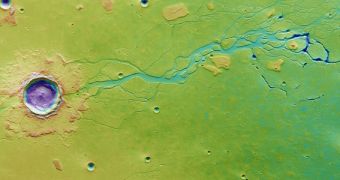This December 28, 2007 image of a small portion of the Martian surface was collected by the European Space Agency (ESA) Mars Express spacecraft, as it was flying several hundred kilometers above the surface of the Red Planet. It shows in great detail a series of large, carved canals stemming from a large crater.
This entire area – located in the northern hemisphere and called Hephaestus Fossae – was battered by space rock collisions millions of years ago, and the carved landscape is a result of these impacts. The largest crater in this image is around 20 kilometers (14 miles) across.
The deep depressions that stretch to the upper right portions of the photo are canals carved by molten material and muddy fluids that were produced following the energetic impact. Some of these small canyons are up to 4 kilometers (2.5 miles) deep.
The water to create mud was vaporized from deep under the Martian surface, where vast amounts of the chemicals exist. The vapors then mixed with vaporized rock debris and dust to form a corrosive mixture that scarred the surrounding landscape for many years after the original impact occurred.

 14 DAY TRIAL //
14 DAY TRIAL //